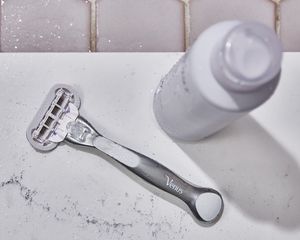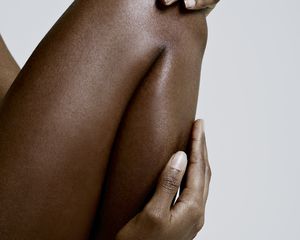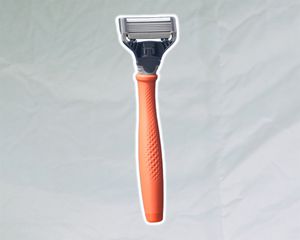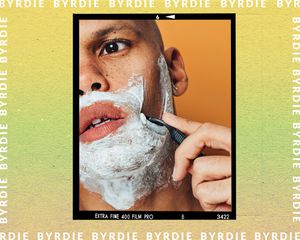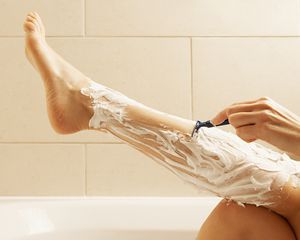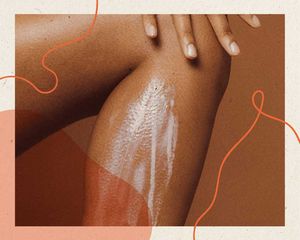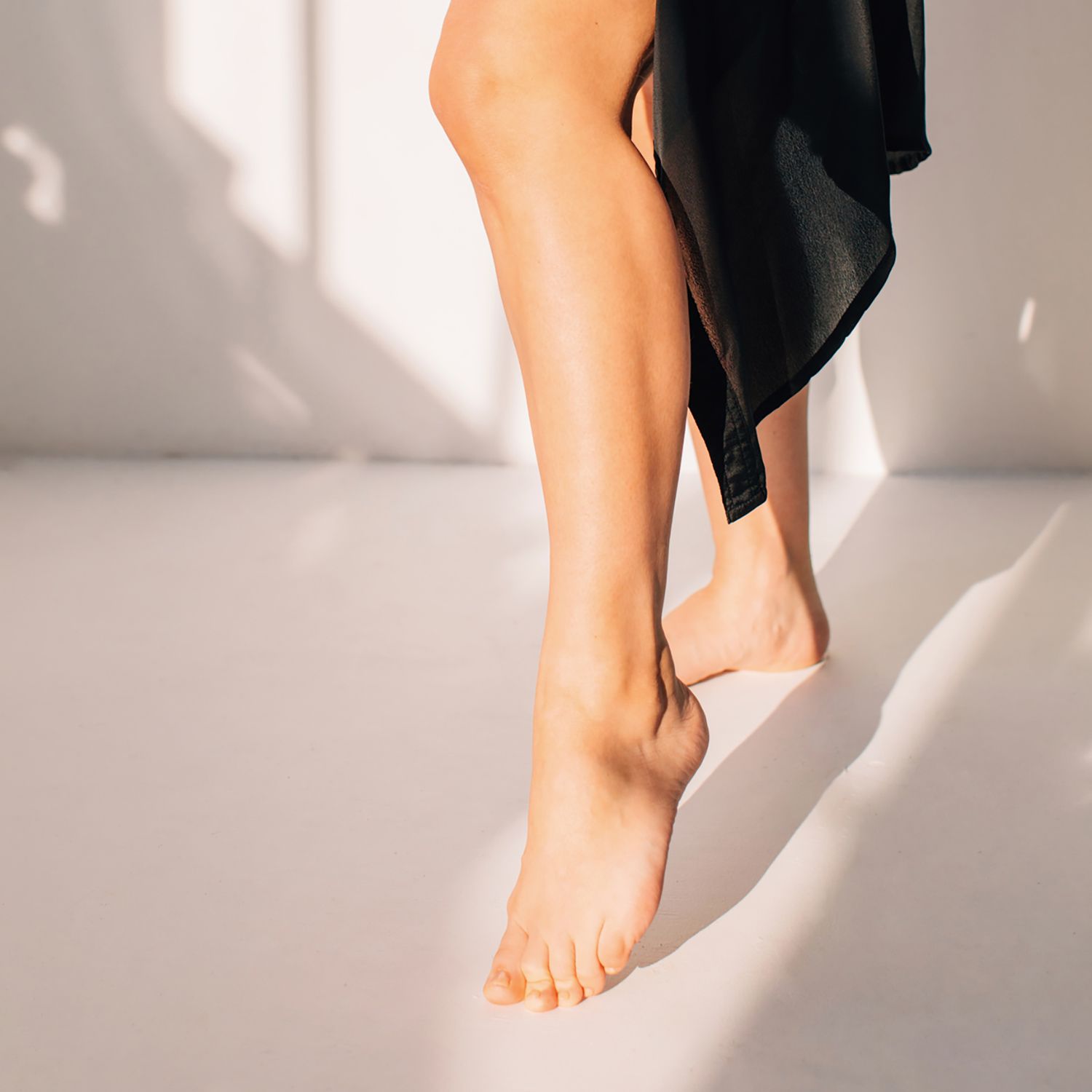
Liliya Rodnikova / Stocksy
Almost every body-owning human has to deal with body hair at one point or another; it's a fact of life. What you do with that body hair, if you choose to do anything at all, is totally up to you. After all, the nicks, burns, ingrowns, and irritation that can come with voluntary hair removal aren't exactly great selling points.
But for those of us who choose to remove our body hair, we know how important it is to do it right. Without proper prep, the cushiest of shaving creams, and the sharpest of blades, shaving is ineffective at best and downright dangerous at worst.
But every so often, a situation arises in which we're found with last-minute, unwanted stubble and no time (or way) to shower. Enter the illusive dry shave. Often considered a cardinal sin of hair removal, dry shaving can be done safely—so long as it's done correctly.
Read on for the safest possible way to shave your legs, according to board-certified dermatologists Onyeka Obioha-Lolagne, MD, and Ranella Hirsch, MD, and esthetician Jodi Shays.
Meet the Expert
- Jodi Shays is an esthetician and the owner and founder of Queen Bee Salon & Spas in Culver City, California, and Seattle, Washington.
- Onyeka Obioha-Lolagne, MD, is a board-certified cosmetic and medical dermatologist based in Los Angeles.
- Ranella Hirsch, MD, is a board-certified dermatologist based in New York City.
Is It Safe to Dry Shave Legs?
Good news: All our experts agree that, while not ideal, dry shaving is absolutely safe—so long as you follow the right precautions. "Dry shaving really should only be performed in a pinch," Shays explains. "Taking a razor to cold, bare skin that isn't prepared is a major red flag for the largest organ on your body. It will communicate to the brain that it is under attack, and that is why many people complain about inflammation after a true dry shave."
And speaking of a "true" dry shave, it's important we're all on the same page about what that means. Simply put, dry shaving is shaving an area on your body outside of the shower without any water whatsoever, Obioha-Lolagne shares.
Traditionally, we're taught to shave using warm water and shaving cream. Water, especially at higher temperatures, softens the skin and allows for smoother hair removal. The addition of shaving cream or a similar emollient makes for an easier, safer razor-blade glide, Shays says. Plus, Obioha-Lolagne adds, it reduces the risk of post-shaving irritation and folliculitis (AKA inflammation around the hair follicles).
Hirsch does add the caveat that while dry shaving can be safe, "safe depends on who is doing the shaving and how it's done—technique is key."
Benefits of Dry Shaving Legs
There's really only one benefit to dry shaving with a traditional razor blade, and that is occasional convenience.
Consider dry shaving a last resort, for those rare moments when the stubble needs to go stat and you find yourself totally water-less. And given the necessity of proper dry shave precautions and techniques, it might just be easier (and definitely less risky) to wait for a proper shave later.
Risks of Dry Shaving Legs
Here's where things get complicated because there are a lot of potential risks when it comes to dry shaving. These risks are even more pronounced if you're using a dull razor and/or not using any kind of lubrication. These include:
- Irritation and inflammation: If you're after a pain-free close shave, dry shaving might not be your best bet. Without proper prep work and protection, you can end up with abrasions, irritation, and inflammation, all of which can lead to more serious issues down the line, according to Hirsch.
- Dry, flaky skin: There's a reason we're taught to shave using plenty of hydration and moisture: Shaving dries skin out. Without nourishing ingredients and emollient agents, the skin can end up extra dry, scaly, and flakey post-dry shave.
- Cuts and fissures: If your skin is already dry and sensitive, dry shaving will likely cause nicks and cuts, which are slightly painful and annoying but can also cause larger issues if bacteria enter the wound, Hirsch warns. Even if the skin is well-moisturized, the absence of water and proper lubrication makes snags and cuts all the more likely.
- Stinging, itching, or burning sensations: Dryness and irritation, two major risks when dry shaving, can lead to itching, stinging, and burning sensations that last long after the job is done, says Shays.
- Razor burn: Without any sort of softening agent or enough slip, dry shaving can lead to razor burn, which presents as blotchy, red, irritated skin.
- Uneven results: The whole point of shaving is to give skin that smooth, soft feel by removing hair. But without ample product and prep work, a razor won't gently glide over the skin and catch every hair. By shaving dry, you risk uneven results and lingering stubble.
- Folliculitis: Folliculitis, which is usually triggered by a bacterial or fungal infection, causes inflammation around the hair follicle and presents as itchy and/or painful raised bumps, according to Obioha-Lolagne. Dry shaving makes the condition all the more likely.
- Ingrown hairs and similar shaving bumps: No one likes ingrown hairs and bumpy skin post-shave, and the risk is far greater when shaving dry.
How to Dry Shave Your Legs the Right Way
Yes, dry shaving is risky. But, if done properly, it's also totally okay when the situation calls for it (so long as it's a rarity).
First and foremost, Hirsch notes that perhaps the safest way to dry shave is to use an electric shaver. These are often made with dry shaving in mind.
If you plan to stick to a regular blade razor, read on for our experts' best tips on how to dry shave your legs the right way, minimizing risk and maximizing results.
- A dull blade is risky even when shaving properly, so be sure you're using a sharp blade (or a new one altogether, if you can swing it). And you don't have to get all fancy with it: Disposable razors work just fine, so long as they're fresh and disposed of after one use.
- Before dry shaving, our experts highly recommend lubricating the skin by applying a thick layer of shaving cream, gel, or oil. Shays suggests some waterless product, like coconut oil or sunflower oil. Hirsch agrees, sharing that she's more likely to recommend an oil over shaving cream when it comes to dry shaving—or better yet, she says, some sort of moisture strip on the blade to lubricate without any hassle. Meanwhile, Obioha-Lolagne says to look for products with emollients like glycerin, shea butter, and oats.
- As with razors, there's no need to shell out a ton of cash for effective shaving products. Obioha-Lolagne says she's a fan of Aveeno's Therapeutic Shave Gel ($6), which features a soothing oat-based formula formulated for sensitive and easily irritated skin, and Vanicream's Shave Cream ($10), which creates a protective barrier between the razor and skin to avoid irritation and contains moisture-locking ceramides. Whether you use an oil, gel, or cream, the goal is to find something so hydrating, thick, and moisturizing that you won't even need aftershave products (because if we're resorting to dry shaving, we're most definitely on a major time crunch).
- Once you're all lubed up, hold the skin taught with one hand and shave slowly in the direction of your hair growth. This will likely mean shaving in a downward motion (though your instinct might be to go against the grain). Use a light touch and long, sweeping strokes to be sure you catch every hair—Obioha-Lolagne says shaving over the same area more than once is a major dry shaving no-no.
And that's really it. We should mention following these tips won't get you completely out of the woods risks-wise. But they're effective enough that all three of our experts deem dry shaving safe when following these techniques.
Some other tips: Don't dry shave over areas that are already inflamed, bumpy, or irritated—the same goes for any areas with eczema or psoriasis outbreaks, Shays says. And when dry shaving an area where the hair is longer than an inch or so, trim it down before picking up the razor.
The Final Takeaway
While dry shaving can be risky, following the right protocol can seriously lower the possibility of mishaps. When done correctly, dry shaving is totally okay (so long as it's infrequent).
Should you be dry shaving weekly or even monthly? Definitely not. But for those once-in-a-blue-moon moments, go ahead—just take precautions and do it the right way. If not, just deal with the hair until you can take your time and give yourself a real proper shave.



